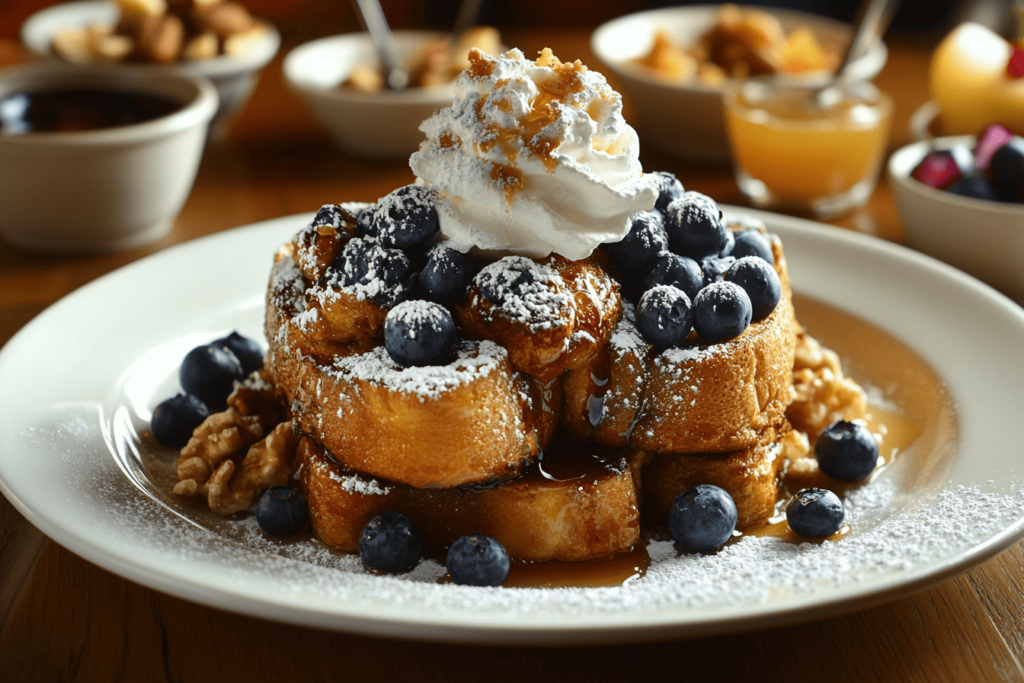French toast is a classic breakfast treat that has stood the test of time, but not all bread is created equal when it comes to achieving that perfect slice. Among the many contenders, sourdough bread stands out as a robust, flavorful choice. This article dives into why sourdough bread is an excellent option, the science of making great French toast, and tips for perfecting your recipe. We’ll also explore common pitfalls, creative variations, and frequently asked questions to guide you toward French toast perfection. Let’s start with why sourdough deserves the spotlight!
Why Sourdough Bread is a Great Choice for French Toast
What Makes Sourdough Bread Unique?
Sourdough bread isn’t your average loaf; it has a distinctive tangy flavor that sets it apart. This flavor comes from the natural fermentation process, where wild yeast and lactic acid bacteria work together to create a harmonious taste. When paired with the sweetness of syrup, fruits, or a dusting of powdered sugar, sourdough French toast offers a balanced profile that excites the palate. check out our detailed guide on Toast with Sourdough Bread.
Moreover, sourdough bread’s natural complexity brings a unique dimension to French toast. The fermentation process enhances the bread’s digestibility, thanks to its lower gluten content compared to regular bread, making it an attractive option for health-conscious breakfast enthusiasts.
Texture and Sturdiness of Sourdough Bread
What really makes sourdough bread shine is its sturdy texture. Unlike softer breads that might turn to mush when soaked, sourdough’s firm crumb structure absorbs the custard mixture evenly without falling apart. The result? A perfectly moist yet crisp slice of French toast.
Sourdough’s chewy crust also adds a delightful contrast to the soft, custard-infused center. When cooked, this crust develops a golden-brown finish that’s irresistibly appealing, both in taste and appearance.
Nutritional Benefits of Sourdough Bread
Beyond its taste and texture, sourdough bread packs a nutritional punch. It contains prebiotics and probiotics from the fermentation process, which support gut health. Compared to standard sandwich bread, sourdough has a lower glycemic index, meaning it won’t spike blood sugar levels as much.
For French toast lovers, this means you can indulge without feeling overly guilty. Plus, the lower sugar content of sourdough makes it an excellent canvas for both sweet and savory toppings, giving you endless creative freedom in the kitchen.
The Science Behind Perfect French Toast
The Role of Bread in Absorbing the Custard Mixture
Creating the perfect French toast starts with understanding how bread absorbs custard. Sourdough bread, with its dense yet airy crumb, is a standout choice because it strikes a balance between soaking up the custard and maintaining its structure. The sturdy texture of sourdough bread ensures that it doesn’t disintegrate during the soaking process, unlike softer sandwich breads that can turn soggy.
When using sourdough, soak each slice just long enough to let the custard penetrate the bread’s surface without oversaturating it. A common tip is to soak for about 20–30 seconds per side, but this can vary depending on the freshness and thickness of the bread. Fresher sourdough might need less time, while slightly stale bread can handle a longer soak, making it an excellent way to use leftover sourdough loaves.
Cooking Techniques for Sourdough French Toast
The way you cook your French toast also impacts its texture and flavor. Using medium heat is key to ensuring the custard cooks through without burning the outside. Sourdough’s natural firmness allows it to achieve a golden-brown crust while keeping the inside soft and custardy.
Pro tip: Use butter and a splash of neutral oil in the skillet for an evenly browned surface that doesn’t stick. For an extra crispy edge, consider sprinkling a pinch of sugar on each side of the bread before cooking. This creates a caramelized finish that pairs beautifully with the tangy sourdough flavor.
How to Choose the Best Sourdough Bread for French Toast
Selecting the Right Loaf
Choosing the right sourdough bread is crucial for French toast success. The best options are artisanal loaves with a thick crust and a well-developed crumb structure. These loaves hold up to soaking and cooking without losing their shape. If you bake your own bread, aim for a slightly less airy loaf for better absorption.
Homemade sourdough bread is ideal, as it lets you control the texture and ingredients. However, high-quality store-bought options can also work well. Look for loaves with minimal added sugar or preservatives, as these can alter the custard’s flavor.
Thickness of Slices
When it comes to slicing, thicker is better. Aim for slices about ¾ to 1 inch thick to ensure they can soak up the custard while retaining a firm center. Uniform slices also cook evenly, avoiding undercooked or burnt edges. For those using leftover sourdough, slightly stale bread works wonderfully because it absorbs the custard mixture more efficiently without falling apart.
To achieve clean, even slices, use a serrated knife. This helps prevent tearing, especially with crusty sourdough loaves. Preparing consistent slices makes the cooking process smoother and ensures every bite is a delicious balance of crispy crust and soft interior.
Sourdough French Toast Recipe Variations

Classic Sourdough French Toast Recipe
Making classic sourdough French toast is both simple and rewarding. Here’s a step-by-step guide to mastering this breakfast favorite, don’t miss Sourdough French Toast: A Classic Twist on a Breakfast Favorite for more tips and ideas to perfect this dish.
Ingredients:
- 4 slices of sourdough bread
- 3 large eggs
- ½ cup whole milk (or any milk alternative)
- 1 teaspoon vanilla extract
- 1 teaspoon cinnamon
- 1 tablespoon sugar (optional)
- Butter for cooking
Instructions:
- In a shallow dish, whisk together the eggs, milk, vanilla, cinnamon, and sugar until well combined.
- Heat a skillet over medium heat and melt a small pat of butter.
- Dip each slice of sourdough into the custard mixture, ensuring both sides are fully coated but not oversoaked.
- Cook the slices for 2–3 minutes per side or until golden brown.
- Serve with your favorite toppings like syrup, fresh fruit, or powdered sugar.
This recipe showcases the tangy and hearty qualities of sourdough, making it a hit for brunch or weekend breakfasts.
Creative Variations
Why stick to the basics when sourdough bread lends itself to so much versatility? Here are some creative twists to elevate your French toast game:
- Cinnamon Sugar Delight: Sprinkle a mix of cinnamon and sugar on each side before cooking for a caramelized crust.
- Savory Sourdough French Toast: Skip the cinnamon and sugar, and add herbs like rosemary or thyme to the custard. Top with a fried egg, avocado slices, or smoked salmon for a savory breakfast.
- Berry Bliss: Add fresh berries like blueberries or raspberries to the custard mixture for a fruity surprise in every bite.
- Chocolate Dream: Spread Nutella between two slices of sourdough, then dip and cook for a decadent stuffed French toast.
For more delicious ideas, check out other creative brunch recipes on our website.
Common Mistakes to Avoid When Using Sourdough Bread for French Toast
Over-Soaking the Bread
One of the biggest challenges in making French toast with sourdough is avoiding over-soaking the bread. While sourdough is sturdy, soaking it for too long can result in a soggy, unpleasant texture. To prevent this, aim for a quick dip—just enough to coat the bread thoroughly without saturating the center. Use slightly stale sourdough bread when possible, as it’s better at absorbing the custard without becoming mushy. visit our post on is Sourdough Bread Not Fattening?.
If you accidentally soak the bread too long, try drying it out slightly before cooking by placing it on a wire rack for a few minutes. This trick can save your French toast from becoming a soggy disaster.
Using Stale or Poor-Quality Sourdough
While sourdough bread is great for using up leftovers, there’s a limit to how stale it should be. If the bread is too hard, it won’t absorb the custard evenly, leading to dry spots in your French toast. On the flip side, overly fresh sourdough might fall apart during cooking. Strike a balance by using bread that’s one to two days old.
When buying sourdough, opt for artisan or homemade loaves whenever possible. These are often free of preservatives and have a better structure for French toast. Lower-quality, mass-produced sourdough may not hold up as well, both in texture and flavor,
FAQs About Using Sourdough Bread for French Toast

Why is sourdough bread a good option for French toast?
Sourdough bread is an excellent choice for French toast because of its unique flavor and sturdy texture. The natural tanginess of sourdough pairs beautifully with the sweetness of syrup, cinnamon, and fruits. Its hearty crumb absorbs the custard mixture without turning soggy, creating a satisfying bite every time. If you’re tired of bland, overly soft French toast, sourdough is a game-changer.
How is sourdough French toast different from regular French toast?
The main difference lies in the flavor and texture. Regular French toast, often made with white bread, tends to be milder and softer. Sourdough French toast, however, offers a rich, tangy flavor and a firmer texture that holds up better during cooking. This makes sourdough ideal for recipes that require thicker slices or creative toppings, giving your dish a gourmet twist.
Can stale sourdough bread be used for French toast?
Yes, slightly stale sourdough bread is perfect for French toast! In fact, day-old bread absorbs the custard mixture more effectively than fresh bread. However, avoid using bread that’s too hard or dry, as it won’t cook evenly and might result in tough, unappetizing slices.
What toppings work best with sourdough French toast?
Sourdough French toast shines with both sweet and savory toppings. Classic options like maple syrup, powdered sugar, and fresh berries work beautifully. For a savory take, try topping it with fried eggs, avocado, or even crispy bacon.
Conclusion and Final Thoughts
Sourdough bread is a standout choice for making French toast, offering the perfect blend of flavor, texture, and versatility. Its sturdy structure absorbs the custard mixture without falling apart, while its tangy flavor elevates this breakfast classic to a whole new level. Whether you prefer traditional recipes or creative variations, sourdough French toast can suit any taste.
As this article has shown, success with sourdough French toast lies in the details—choosing the right loaf, cutting the slices to the right thickness, and mastering the soaking and cooking techniques. Avoid common mistakes like over-soaking or using overly stale bread, and you’ll create a dish that’s both delicious and satisfying.
If you’re feeling adventurous, explore creative recipes like stuffed sourdough French toast or savory variations. Sourdough’s versatility means you’re only limited by your imagination. Whether you’re cooking for a special brunch or just a cozy weekend breakfast, this dish is sure to impress.
So, does sourdough bread make good French toast? Absolutely! It’s a breakfast worth savoring, and with these tips, you’re well on your way to creating a memorable meal. Try it out, and let your taste buds be the judge!

